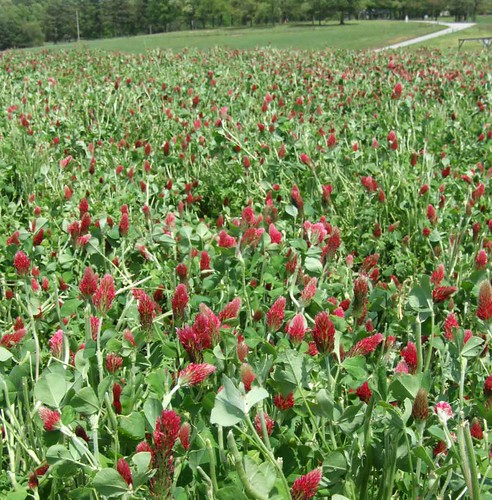Fall is time to plant annual legumes into dormant warm-season grasses
By Gail Halleck
U of A System Division of Agriculture
Fast facts:
-
- Warm season grasses go dormant in colder temperatures, reducing competition when overseeding with other forages.
- Crimson clover, arrowleaf clover are good choices to serve as cover crops as well
- Plant winter legumes no later than Oct. 1
(442 words)
(Newsrooms: with art at www.flickr.com/photos/uacescomm/8078779115/in/photolist-diTRz6-diTRBT)
FAYYETTEVILLE, Ark. – While the bermudagrass is away, the cool-season species will
play. Many producers in the Arkansas and the southeastern U.S. have bermudagrass pastures
that experience slow growth when night temperatures fall substantially, making it
an ideal time to plant winter cover crops such as annual legumes.

“Winter annual legumes have several advantages, such as being easily planted into warm-season pastures, provide highly nutritious forage for grazing in spring, replace parts of nitrogen fertilization, and make a good general cover crop,” said Dirk Philipp, associate professor of forages at the University of Arkansas System Division of Agriculture. He lists crimson clover and arrowleaf clover as all good winter cover crop choices.
Philipp said “fallow fields or unused areas along creeks that need some bank mitigation and cover during the wintertime” are also suitable areas for planting winter annual legumes.
There are important considerations to make before planting for spring forage:
- Plant no later than Oct. 1 to ensure good seedling emergence and leaf development before winter sets in.
- Control bermudagrass canopy by grazing closely to the ground; the shorter the canopy, the less competition from the sod, even if it will become dormant in a few weeks.
- Use a no-till drill to plant no deeper than a quarter-inch to a half-inch. Set up drill properly before planting.
- Check soil fertility (pH, phosphorus and potassium) before planting and apply amendments as needed. Note that lime application will not correct pH in the short term.
In spring, Philipp says grazing should begin when the canopy height is about 12 inches, and grazed down to 4 inches but no deeper. He said it is important to scout fields to not miss this prime time to start grazing because forage can grow fast in spring and this window can easily be missed. This practice can sometimes produce a second grazing out of the stands and when grazed, clovers will hardly reseed.
Crimson and arrowleaf clovers are best suited for grazing as they are both relatively low in dry matter, so cattle get used to high-quality forage. Philipp says bloat shouldn’t be a problem if some hay or early fescue forage is provided.
For use as cover crops, both clovers produce a dense stand that can shade out bermudagrass and can be used in areas that should be reclaimed or restored, or on fallow fields for winter cover and weed control.
If left ungrazed, these legumes will reseed by themselves and create large seed banks over the years, so no reseeding will be required.
All these legumes provide some level of habitat, serve as pollinator plants, and may add nitrogen back to the soil over the long term, said Philipp.
For more information about forages, contact your county extension office or visit www.uaex.uada.edu.
Pursuant to 7 CFR § 15.3, the University of Arkansas System Division of Agriculture offers all its Extension and Research programs and services (including employment) without regard to race, color, sex, national origin, religion, age, disability, marital or veteran status, genetic information, sexual preference, pregnancy or any other legally protected status, and is an equal opportunity institution.
# # #
Media Contact: Mary Hightower
Dir. of Communication Services
U of A Division of Agriculture
Cooperative Extension Service
(501) 671-2126
mhightower@uada.edu
Related Links